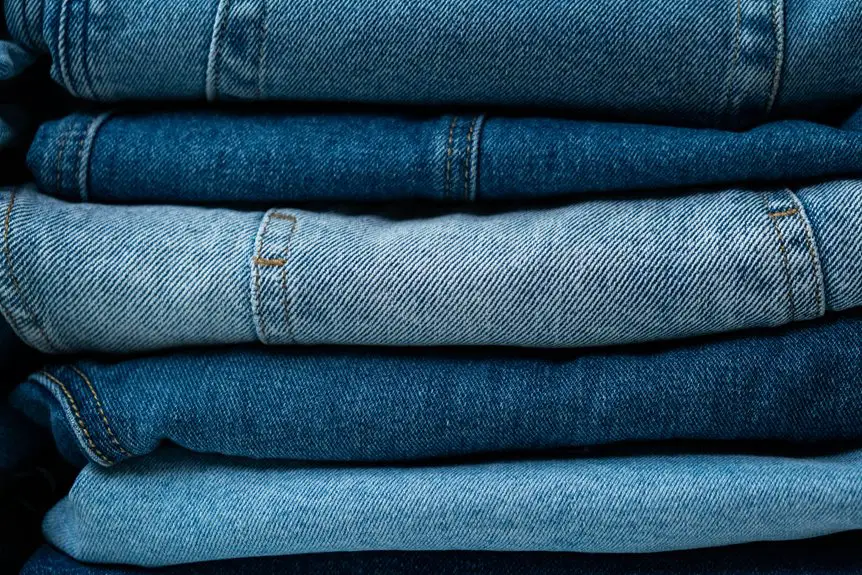To stop fabric dye from running, start by pre-washing your fabrics to remove any chemicals. Always use cold water for washing to prevent dye bleeding. Incorporate vinegar as a fixative by soaking your fabric in a vinegar solution for 30 minutes before rinsing. Sort your laundry by color and choose gentle detergents labeled for delicates. These simple tricks will help keep your colors vibrant and intact. There’s more to discover about maintaining your fabrics!
Table of Contents
Key Takeaways
- Pre-wash fabrics to remove sizing, dirt, or chemicals that may cause dye running.
- Always wash in cold water to prevent dye bleeding and fading.
- Use vinegar as a fixative by soaking fabric in a vinegar-water solution for 30 minutes.
- Sort laundry by color to avoid dye transfer between garments.
- Choose gentle, color-safe detergents to minimize the risk of dye running.
Pre-Wash Your Fabrics
Before diving into your dyeing project, it’s essential to pre-wash your fabrics. This step helps remove any sizing, dirt, or chemicals that could interfere with dye absorption.
Start by checking the care labels on your fabrics to determine the best washing method. Use a gentle detergent, and wash your fabrics in warm water unless specified otherwise. After washing, don’t forget to rinse thoroughly to eliminate any leftover detergent.
Once clean, allow your fabrics to air dry or tumble dry on low heat. Pre-washing not only prepares your fabrics for dyeing but also helps achieve more vibrant, even colors.
Use Cold Water for Washing
After pre-washing your fabrics, the next step to guarantee your dye remains vibrant is to use cold water for washing. Cold water helps prevent dye from bleeding and fading, ensuring your colors stay true.
When you wash in hot water, you risk loosening the dye molecules, which can lead to a dull appearance or unwanted color transfer.
Always check the care label on your fabric, but most dyed materials respond well to cold water. If you’re using a washing machine, select a cold cycle to minimize agitation and heat exposure.
Remember, consistent cold washing not only protects your colors but also saves energy, making it an eco-friendly choice.
Incorporate Vinegar as a Fixative
One effective way to enhance the longevity of your fabric dye is to incorporate vinegar as a fixative. Vinegar can help set the dye, preventing it from bleeding during washes. To use it, simply mix one part vinegar with four parts water, and soak your fabric for about 30 minutes before rinsing. This simple step could save you from color mishaps down the line.
| Step | Action | Notes |
|---|---|---|
| 1 | Mix vinegar and water | Use a bowl or basin |
| 2 | Soak fabric for 30 minutes | guarantee it’s fully submerged |
| 3 | Rinse thoroughly with cold water | Remove any vinegar smell |
Sort Your Laundry by Color
To keep your fabric looking vibrant and prevent dye from running, sorting your laundry by color is a smart move. Start by separating your whites, darks, and colors. This simple step helps avoid any unwanted dye transfer during the wash cycle.
Dark items, like navy or black, can bleed onto lighter fabrics, ruining their appearance. By grouping similar colors together, you minimize the risk of this happening. If you’re unsure about a new garment, consider washing it separately the first time.
Additionally, monitor any pieces that have a tendency to bleed, and wash them with caution. Taking a few extra minutes to sort your laundry can save you from the hassle of dealing with discolored clothes later.
Choose Gentle Detergents
Choosing gentle detergents can significantly reduce the risk of fabric dye running, especially for delicate items.
These milder formulas are designed to clean without stripping away the dye, helping maintain your garment’s vibrant colors. When you opt for a gentle detergent, look for those labeled as “color-safe” or “for delicates.”
Avoid harsh chemicals and bleach, as they can cause fading and bleeding. It’s also a good idea to use cold water when washing, as it further minimizes dye transfer.
Remember to check the care label on your fabric to verify compatibility with your chosen detergent.
Frequently Asked Questions
What Types of Fabrics Are Most Prone to Dye Bleeding?
Certain fabrics, like cotton, rayon, and silk, are more prone to dye bleeding. When washing, you should always check care labels and wash similar colors together to minimize any risk of color transfer.
Can I Use Bleach With Colors Safely?
Imagine juggling vibrant balloons; one wrong move, and they burst. You can’t safely use bleach with colored fabrics, as it often leads to unwanted fading or splotches. Stick to color-safe alternatives for peace of mind.
How Often Should I Wash Colored Fabrics?
You should wash colored fabrics every few wears, depending on how soiled they get. Always check care labels for specific instructions, and consider using cold water to help maintain the vibrancy of the colors.
Does Washing in Hot Water Set Stains?
Washing in hot water can actually set stains, making them harder to remove. It’s usually better to wash stained fabrics in cold or lukewarm water, which helps prevent stains from becoming permanent.
What Are the Signs of Dye Bleeding in Laundry?
You’ll notice dye bleeding in laundry if colors appear on lighter fabrics, water turns tinted during washing, or if items feel sticky after drying. Always check for these signs to prevent color mishaps in future loads.
- Understanding Fabric Dye Types to Prevent Bleeding - June 10, 2025
- My New Red Shirt Bled Everywhere: What Now? - June 10, 2025
- Does a Retayne-Type Product Stop Fabric Bleeding Effectively? - June 10, 2025



